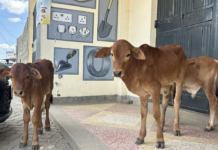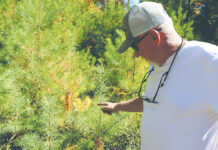FREEPORT, Ohio – You would think a professional forester gets enough of trees during the day. But Frank Corona can’t wait to get home from work and head back out outdoors.
And his 113-acre certified tree farm in southwestern Harrison County is proof that attention to conservation details pays dividends. Timber sales. More wildlife. Healthier trees. Improved pasture grass.
Corona and his wife, Trish, hosted the Harrison Soil and Water Conservation District’s conservation field day Aug. 10 to spotlight their conservation measures. Approximately 130 people visited the farm to view the pasture management and timber stand improvement practices.
Lots of work. In 1994, Corona, a district forester with the Ohio Department of Natural Resources, bought the property, complete with a dilapidated 1800s log cabin and acres of woods and pastures abandoned by the previous absentee owners.
The Coronas first worked to make the house habitable, planted 6 acres of pine trees and sold timber to help create a trail system through the woods.
The trails, built according to best management practices to minimize erosion and soil disturbance and protect water quality, double as access roads.
There are nearly 4 miles of trails through the woods. In addition to using the trails for tractor work in the woods, the Coronas use them for hiking and trail rides, although there never seems to be enough time for the leisure uses, they add.
“We don’t get to ride enough,” admitted Trish Corona. “We just work furiously and think ‘someday’.”
Timber stand. Two timber sales at the farm, one in 1997 and the second in 2005, removed approximately 2,000 hardwood trees, but you’d never know it by looking at the healthy, good-sized trees that remain throughout the woods.
Corona also works to control grapevine on about 100 acres, removing most of it except for areas he is specifically developing for wildlife. He also plants and maintains food plots in meadows near the wooded wildlife areas he is targeting. Since they’ve bought the farm, they’ve seen an increase in the population of wild turkeys, rabbits, coyotes and deer.
He also completed an 8-acre timber stand improvement to control multiflora rose and spice bush.
Pasture management. Recently, the Coronas turned their attention to pasture management and developing a paddock area for their five Arabian horses. Using their own wood, they fenced in about 11 acres in three different pastures, built an all-weather round pen, laid a water line from the barn to the far paddock, and created a pressurized water system with waterers that can be accessed by the horses on either side of the fence.
The Coronas worked closely with the USDA’s Natural Resources Conservation Service and the local soil and water conservation district to get ideas, like a heavy use pad around the waterers, and create the land management plans.
They’ve also cut their own trees to be used for a 60-by-80 barn built in 2005, hiring a portable band saw to create the boards.
Sharing enthusiasm. Because of his work as a forester, Frank Corona feels strongly about the information and education opportunities in his conservation work, which is why the family agreed to host the field day. They’ve hosted numerous other tree farm outings and educational tours.
“It doesn’t pay just to sit on it [woodland], Corona said.
During the evening program, three wagons kept the visitors circulating through the woods to specific tour information stops.
(Farm and Dairy Editor Susan Crowell can be reached at 800-837-3419 or at editor@farmanddairy.com.)
Get 4 Weeks of Farm and Dairy Home Delivered









